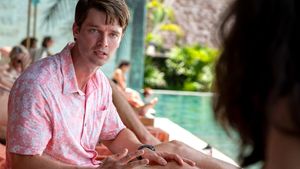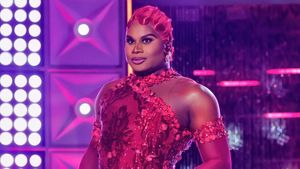I'm in love with tiny TV. Not tiny TVs. No, in fact, our home has five televisions (plus a jailbroken Fire TV Stick, a Chromecast, a Roku, an Xbox One, and Shield TV -- all for our viewing pleasure). The actual TV screens get bigger each year, until the point when my co-pilot starts arguing that the money I'd like to spend on a newer-faster-bigger wide-screen, flat-panel, smart television would be better suited for purchases like groceries or garbage pickup. Picky.
No, I'm in love with tiny television shows, the current bumper crop of lifestyle reality TV series about tiny living. There's Tiny House, Big Living; Tiny House Hunting; Tiny House Hunters; Tiny House World; and my favorite, Tiny House Nation, which is popular with the gays (as grandma says) thanks in large part to its silver fox host John Weisbarth and his super-hot pro skier-turned-builder Zack Giffin.
Everyone in the now decade-old small-house movement dreams of building, buying, or somehow inhabiting one of these under-400-square-feet tiny houses. Some are under 200 square feet, built atop a trailer with wheels, and offer remarkably ingenious options like climbing walls, hidden drawers, and horse-trough bathtubs.
Earlier this year I went on a bender, watching all of these shows on HGTV and DIY (both owned by Scripps Networks Interactive, the company that started this type of reality TV genre) and FYI (the A&E network meant to appeal to women in their 40s who, network president Jana Bennett told The Hollywood Reporter, are interested in "improvised living").
That's apparently me, because my tiny-house swooning and fascination with extreme downsizing brought on by watching all these shows led us to buy our own teeny tiny home: a 6-by-22-foot house on wheels that is being built for us by a tiny-home builder in Utah.
Two years ago we entered a similar cycle when we bought our first home (no wheels) in rural Southern California after watching House Hunters reruns endlessly for the last 17 years. I don't usually make purchasing decisions based on what I see on TV, but it's clear that I wouldn't have purchased either of these houses without the influence of HGTV, nor would I have had the language to do so.
Even better is the ordinariness with which House Hunters -- HGTV's highest-rated series, at around 1.6 million viewers each episode -- and its many successors treat different families, couples, and single people. The first few episodes, it was thrilling to see a same-sex couple treated so casually, as if it were no big deal. These couples became so routine that their inclusion seemed hardly worthy of note.
"HGTV and House Hunters et al. have been incredible with diversity," says Fay Wolf, Apartment Therapy's go-to expert and one of Los Angeles's most popular celebrity organizers. A lesbian
who counts Emily Deschanel and Jesse Tyler Ferguson among her clients, Wolf has seen her New Order: A Decluttering Handbook for Creative Folks (and Everyone Else) become the new "it" book, replacing Marie Kondo's New York Times best seller The Life-Changing Magic of Tidying Up on Hollywood coffee tables.
Wolf's popularity owes in part to the genesis of LGB experts on the interior-design, home-organization, house-buying, and renovation shows pioneered on HGTV, many of which were created by lesbian-owned production company Pie Town Productions, creators of House Hunters, its four spin-offs, as well as Flip or Flop, Design on a Dime, and dozens of others.
House Hunters creators Tara Sandler and Jennifer Davidson began casting gay and lesbian couples when the show began and, Sandler told Xfinity in 2014, HGTV has always been on board. "The network said, 'Let's not make a big deal out of it.' They've always said that. 'They're a couple like anyone else.' We don't point anything out and it's been that way since 1998."
That's what Wolf and many of us fans like. "I see so many same-sex couples that it simply feels normal now -- as it should," she says. "It's never like, 'Oh, here's another special episode where the couple is queer.' Instead it's, 'Oh, here's another great episode about human beings dealing with the issues of home life.' That's what progress looks like."
House Hunters was mainstreaming gay couples, lesbian moms, single divorcees, feminine men, stay-at-home dads, butchy women, and any number of nontraditional folks long before politicians evolved on LGBT rights, and nearly two de-cades before the Supreme Court granted us marriage equality.
With a transgender husband in tow when I bought our first home, not a single person we dealt with batted an eyelash, including the real estate agent, mortgage broker, home builders, loan officers, title agents, and inspectors. Lest you think, Oh, that's California, trust me, I'm in a rural burg and "Middle America" begins about 40 miles west of here.
Average Americans wouldn't have gotten to the point of acceptance of gay and lesbian people without HGTV and its knockoffs. (The one caveat: I could say "LGBT," but it's really just the L and G; it's hard to tell if someone falls within a bi or trans framework without their explicitly saying so.)
When I tune in to Rehab Addict and see host Nicole Curtis, sweaty and dirty in a tank top, looking like the lesbian archetype typified by Gina Gershon in Bound, I can't help but think she's made people consider gender and sexual orientation by (a) rarely talking about a husband or boyfriend on screen, (b) having her queer friends helping on certain episodes, and (c) looking as dykey as any woman is allowed on cable TV these days (Rachel Maddow exempted).
HGTV offers up plenty of ordinary queer fare with House Hunters, Flip or Flop, the wonderfully metro Property Brothers (and its many spin-offs), and my current (though less racially and culturally diverse) non-tiny fave, Fixer Upper, which stars an adorable straight mixed-race Christian couple in Waco, Texas, who reinvent houses, love shiplap, and raise lots of cute kids.
I still remember my first queer sightings on TV: Paul Lynde, the wonderfully bitter flamboyant
actor who made gay insinuations I didn't quite understand on Hollywood Squares in the 1970s, and Amanda Donohoe and Michele Greene, who shared TV's first real same-sex kiss on L.A. Law in the early 1990s. The latter came with advertiser boycotts.
Today, the advertisers are lining up for our money, and queer folks show up on HGTV series as contestants, producers, crew, and hosts. Ellen's Design Challenge has all four! Today queer women and men are seen as experts in many fields far beyond the old-fashioned "interior decorator" title afforded to gay men in years past. We're changing TV and it's changing us.
"The media is a very powerful source of influence, so it's important that we see LGBT stories that aren't just used for shock value," says Kenta Seki, the sexy and popular fitness trainer on the new E! Network reality TV show Just Jillian -- whose star is, of course, also queer.
"It's just as important to see us living our everyday lives -- whether it's showing us in leadership positions at work or at home with our families. I definitely think networks and TV shows like House Hunters and Just Jillian are continuing to help our culture be more accepting of the LGBT community."
Through House Hunters alone, American audiences have met Michael, a white, middle-aged gay Golden Girls fan buying a Palm Springs vacation home for all his friends to share in retirement ("Why not a Golden Boys?" he asks the audience); Joy, a 20-something African-American Army vet, and her wife LaToya, who left Hawaii for a tiny house in San Diego; middle-aged, no-nonsense Celine and Jac, a strong-willed lesbian doctor-sculptor couple looking for that tiny house in Portland, Maine; and Juan and Gee, two black Atlanta event planners who've become media personalities and love coaches in the years since their appearance. There are dozens more I could name, and among some of the so-called straight couples there are likely invisible bisexual and transgender people as well.
HGTV, with its progressive inclusion of same-sex couples over nearly two decades, has done more for pushing audiences to accept LGB folks than any prime-time show has. It and its knockoffs FYI and DIY have changed how many Americans look at the concept of "family," all without an ounce of politicking or diatribe on their parts. These shows remind us that most Americans don't care if you're straight or gay. As long as you can afford granite countertops.



















































































